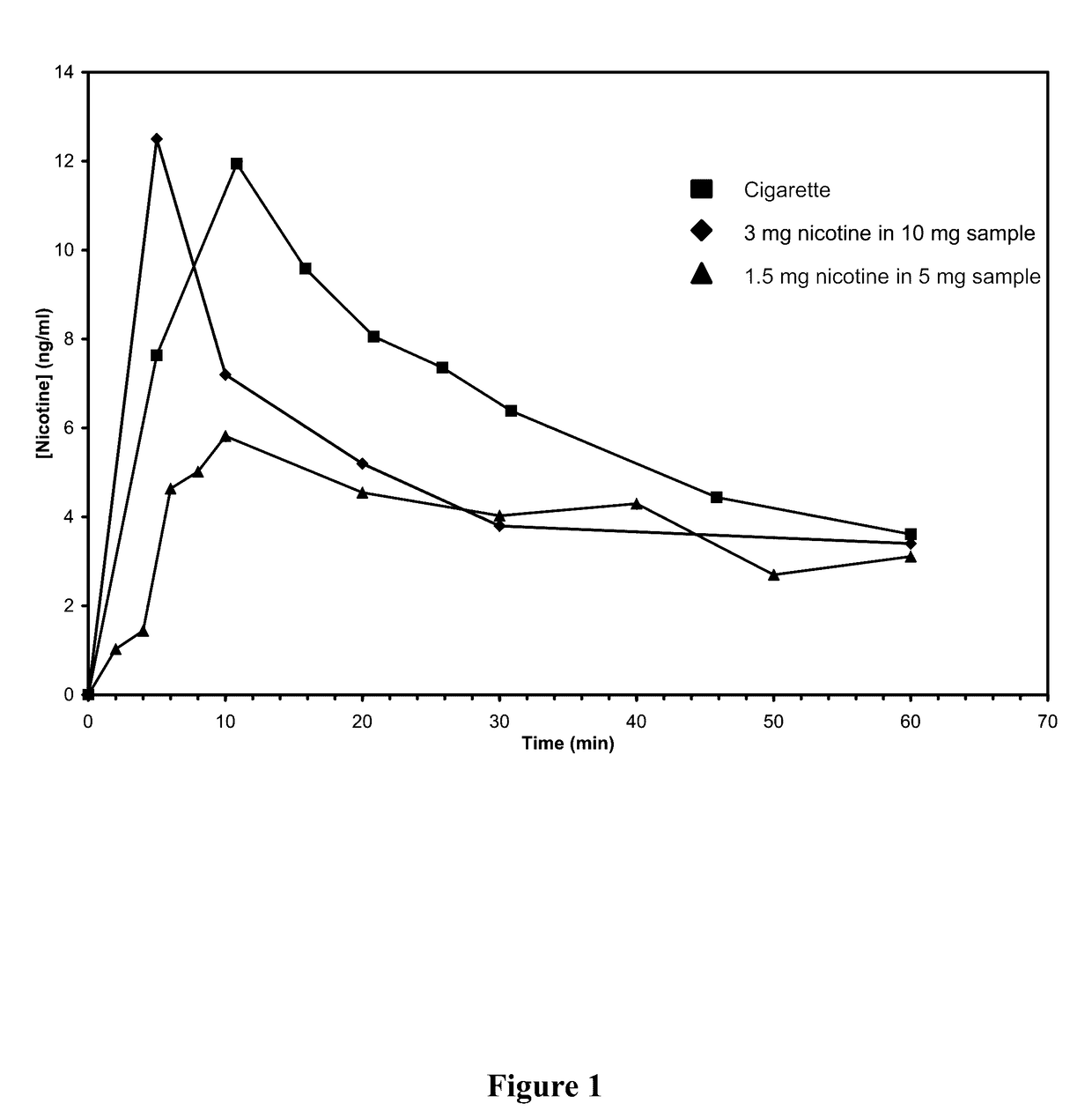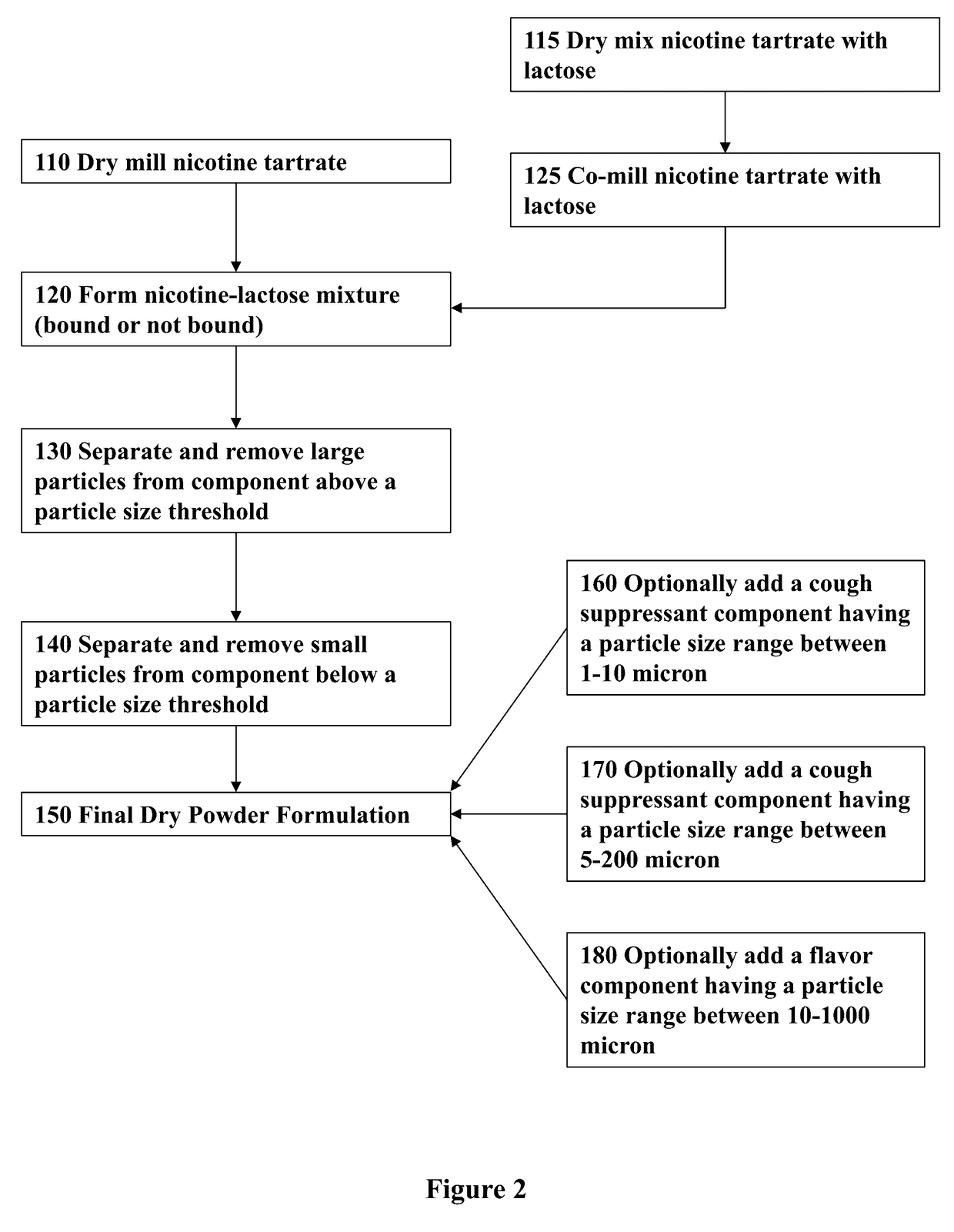Nicotine Formulations and Methods of Making and Using the Same
a technology of nicotine and formulation, applied in the field of nicotine formulation and methods of making and using the same, can solve the problems of high failure rate of smoking cessation attempts, insufficient effectiveness of nicotine replacement products, and inability to completely eliminate nicotine and associated compounds, so as to reduce nicotine cravings, reduce nicotine cravings, and reduce nicotine cravings
- Summary
- Abstract
- Description
- Claims
- Application Information
AI Technical Summary
Benefits of technology
Problems solved by technology
Method used
Image
Examples
example 1
[0075]In a trial for assessing craving reduction, it was shown that embodiments of the invention performed significantly better than commercial products. Subjects who were administered a formulation of the invention consistently achieved a greater reduction in cravings over time as compared to subjects who were administered Nicorette. For example, at 10 minutes after administration of a formulation of the invention containing 2.5% nicotine (based on a delivered nicotine dose of 0.5 mg within the total formulation amount), subjects taking the formulations of the invention had their cravings reduced by about 3.25, while those taking Nicorette only had a reduction of about 2 (FIG. 4A). Similarly, subjects administered a formulation of the invention containing 5% nicotine (based on a delivered nicotine dose of 1.0 mg within the total formulation amount) had their cravings reduced by about 4.25, while those taking Nicorette only had a reduction of about 2 (FIG. 4B). The results were scor...
example 2
[0078]As depicted in FIG. 5, a trial was conducted among 13 subjects to assess the relative nicotine craving reduction achieved upon administration of a formulation containing 2.5% nicotine (0.5 mg nicotine in a 20 mg total formulation amount). The relative craving reduction was assessed after 3 inhalations of the formulations taken over 30 seconds, and then after 4 minutes. All subjects achieved reductions in the relative level of nicotine cravings, with differences ranging from about 1 to 10 after 4 minutes. FIG. 6 is a chart depicting the mean relative reduction in cravings among the subjects. The results demonstrate that the subjects craving score was reduced from 7 before administration to about 4.5 post three inhalations, and to about 1.8 after four minutes.
example 3
[0079]As depicted in FIG. 7, a speed to sensation test was conducted, where the formulation was administered on ten separate occasions to the same subject. The testing included inhalation of a 10 mg formulation containing a 5% nicotine (0.5 mg total nicotine), which is less than 50% of the nicotine absorbed into the body from a single cigarette, and measuring the time to achieve self-reported brain sensation of nicotine, or sensing a nicotine effect. The test revealed a very rapid sensation of nicotine uptake which was 2 to 3 times faster than from a cigarette. In 6 out of 10 trials, nicotine sensation was achieved in times ranging 2.68 to 4.41 seconds, significantly lower than the time it would take blood to flow from the lungs to the brain, as determined by xenon magnetic resonance imaging. These results support the hypothesis that formulations of the invention may activate a neural pathway to cerebral sensation via receptors in the airways, since the results could not be due to n...
PUM
| Property | Measurement | Unit |
|---|---|---|
| Length | aaaaa | aaaaa |
| Length | aaaaa | aaaaa |
| Fraction | aaaaa | aaaaa |
Abstract
Description
Claims
Application Information
 Login to View More
Login to View More - R&D
- Intellectual Property
- Life Sciences
- Materials
- Tech Scout
- Unparalleled Data Quality
- Higher Quality Content
- 60% Fewer Hallucinations
Browse by: Latest US Patents, China's latest patents, Technical Efficacy Thesaurus, Application Domain, Technology Topic, Popular Technical Reports.
© 2025 PatSnap. All rights reserved.Legal|Privacy policy|Modern Slavery Act Transparency Statement|Sitemap|About US| Contact US: help@patsnap.com



